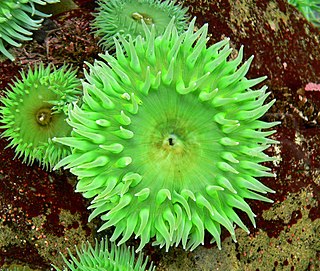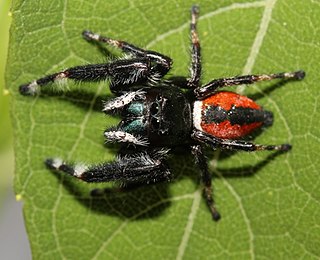
Nemertea is a phylum of animals also known as ribbon worms or proboscis worms, consisting of 1300 known species. Most ribbon worms are very slim, usually only a few millimeters wide, although a few have relatively short but wide bodies. Many have patterns of yellow, orange, red and green coloration. The foregut, stomach and intestine run a little below the midline of the body, the anus is at the tip of the tail, and the mouth is under the front. A little above the gut is the rhynchocoel, a cavity which mostly runs above the midline and ends a little short of the rear of the body. All species have a proboscis which lies in the rhynchocoel when inactive but everts to emerge just above the mouth to capture the animal's prey with venom. A highly extensible muscle in the back of the rhynchocoel pulls the proboscis in when an attack ends. A few species with stubby bodies filter feed and have suckers at the front and back ends, with which they attach to a host.

Sea spiders are marine arthropods of the order Pantopoda, belonging to the class Pycnogonida, hence they are also called pycnogonids. They are cosmopolitan, found in oceans around the world. The over 1,300 known species have leg spans ranging from 1 mm (0.04 in) to over 70 cm (2.3 ft). Most are toward the smaller end of this range in relatively shallow depths; however, they can grow to be quite large in Antarctic and deep waters.

The mouthparts of arthropods have evolved into a number of forms, each adapted to a different style or mode of feeding. Most mouthparts represent modified, paired appendages, which in ancestral forms would have appeared more like legs than mouthparts. In general, arthropods have mouthparts for cutting, chewing, piercing, sucking, shredding, siphoning, and filtering. This article outlines the basic elements of four arthropod groups: insects, myriapods, crustaceans and chelicerates. Insects are used as the model, with the novel mouthparts of the other groups introduced in turn. Insects are not, however, the ancestral form of the other arthropods discussed here.

Phidippus audax, the bold jumper or bold jumping spider, is a common species of spider belonging to the genus Phidippus, a group of jumping spiders easily identified by their large eyes and their iridescent chelicerae. Like all jumping spiders, they have excellent stereoscopic vision that aids them in stalking prey and facilitates visual communication with potential mates during courting. Bold jumping spiders are native to North America and have been introduced to Hawaii, Nicobar Islands, Azores, and the Netherlands. They are typically black with a distinct white triangle on their abdomen.

Misumena vatia is a species of crab spider with a holarctic distribution. In North America, it is called the goldenrod crab spider or flower (crab) spider, as it is commonly found hunting in goldenrod sprays and milkweed plants. They are called crab spiders because of their unique ability to walk sideways as well as forwards and backwards. Both males and females of this species progress through several molts before reaching their adult sizes, though females must molt more to reach their larger size. Females can grow up to 10 mm (0.39 in) while males are quite small, reaching 5 mm (0.20 in) at most. Misumena vatia are usually yellow or white or a pattern of these two colors. They may also present with pale green or pink instead of yellow, again, in a pattern with white. They have the ability to change between these colors based on their surroundings through the molting process. They have a complex visual system, with eight eyes, that they rely on for prey capture and for their color-changing abilities. Sometimes, if Misumena vatia consumes colored prey, the spider itself will take on that color.

Bombylius major is a parasitic bee mimic fly. B. major is the most common type of fly within the Bombylius genus. The fly derives its name from its close resemblance to bumblebees and are often mistaken for them.

The purple shore crab is a common crab of the family Varunidae that is indigenous to the west coast of United States, Canada, and Mexico. H. nudus was first described in 1847 by Adam White, and in 1851, James Dwight Dana formally classified the species. H. nudus is a small, amphibious crab that is similar physically and behaviorally to Pachygrapsus crassipes and Hemigrapsus oregonensis. The purple shore crab is generally a dark purple color with olive green, red, and white spots. Mating season for H. nudus begins in mid-winter and larval crabs undergo 5 zoeal stages and a juvenile stage. Adult crabs mainly feed on algae but will occasionally scavenge other animals. H. nudus prefers inter-tidal and sub-tidal zones, and it can oftentimes be found sheltering under rocks or other debris. H. nudus demonstrates complex compensatory mechanisms to counteract fluctuating salinity and water oxygen concentrations, permitting it to live in a variety of different environments.

Anthopleura xanthogrammica, or the giant green anemone, is a species of intertidal sea anemone of the family Actiniidae.

The six-spotted fishing spider is an arachnid from the nursery web spider family Pisauridae. This species is from the genus Dolomedes, or the fishing spiders. Found in wetland habitats throughout North America, these spiders are usually seen scampering along the surface of ponds and other bodies of water. They are also referred to as dock spiders because they can sometimes be witnessed quickly vanishing through the cracks of boat docks. D. triton gets its scientific name from the Greek mythological god Triton, who is the messenger of the big sea and the son of Poseidon.

Spiders are air-breathing arthropods that have eight legs, chelicerae with fangs generally able to inject venom, and spinnerets that extrude silk. They are the largest order of arachnids and rank seventh in total species diversity among all orders of organisms. Spiders are found worldwide on every continent except for Antarctica, and have become established in nearly every land habitat. As of August 2022, 50,356 spider species in 132 families have been recorded by taxonomists. However, there has been debate among scientists about how families should be classified, with over 20 different classifications proposed since 1900.

Phidippus Clarus, also known as the Brilliant Jumping Spider, is a species of jumping spider found in old fields throughout eastern North America. It often waits upside down near the top of a plant, which may be useful for detecting prey, and then quickly jumps down before the prey can escape. The spider is one of 60 species in the genus Phidippus, and one of about 5,000 in the Salticidae, a family that accounts for about 10% of all spider species. P. clarus is a predator, mostly consuming insects, other spiders, and other terrestrial arthropods.

Pycnogonidae is a family of sea spiders.

Pycnogonum is a genus of sea spiders in the family Pycnogonidae. It is the type genus of the family.

Oregonia gracilis, commonly known as the graceful decorator crab, is a species of crab belonging to the family Oregoniidae. Like other decorator crabs it habitually attaches other organisms to its back. The sessile organisms are attached to hooked setae that act as a sort of velcro attachment. This decoration provides visual and chemical camouflage thus reducing predation risk. Pacific halibut are a major predator of O. gracilis. Other predators include octopus and sea otters. The main food source of O. gracilis is floating kelp and algae that they capture utilizing a waiting strategy in order to maintain cryptosis.

Pugettia gracilis, commonly known as the graceful kelp crab, is a species of small crab in the family Epialtidae. It lives among forests of kelp on the Pacific coast of North America.

Kelletia kelletii, common name Kellet's whelk, is a species of large sea snail, a whelk, a marine gastropod mollusc in the family Buccinidae, the true whelks.

Rossia pacifica, also known as the stubby squid, is a species of bobtail squid native to the northern Pacific Ocean. It usually occurs in winter on sandy slopes away from strong currents in moderately shallow water. In summer it moves to deeper water where it breeds. The female cements the egg capsules under a stone or in some other concealed location, and both male and female die soon after breeding.

Nymphon gracile is a species of sea spider first described by William Elford Leach in 1863. The species highly resembles other members of the genus Nymphon, and species identification from morphological traits alone is, therefore, a complex task.

Eupentacta quinquesemita is a species of sea cucumber, a marine invertebrate with an elongated body, a leathery skin and tentacles surrounding the mouth. It is commonly known as the stiff-footed sea cucumber or white sea cucumber, and occurs on rocky coasts in the northeastern Pacific Ocean.

Pycnogonum litorale is a marine arthropod in the family Pycnogonidae, the sea spiders. It is found in the northern Atlantic Ocean, the North Sea, the English Channel and the western Mediterranean Sea.



















